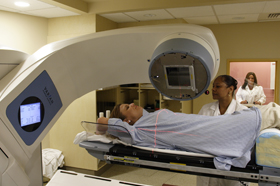Radiation Before Mastectomy Minimizes Treatment Delays and Reduces Number of Surgeries
 Altering the sequence of breast cancer treatment to administer radiation before mastectomy allowed for concurrent breast reconstruction surgery, which reduced the number of operations required, minimized treatment delays and improved patient satisfaction.
Altering the sequence of breast cancer treatment to administer radiation before mastectomy allowed for concurrent breast reconstruction surgery, which reduced the number of operations required, minimized treatment delays and improved patient satisfaction.
The Phase II trial results from researchers at The University of Texas MD Anderson Cancer Center and published in JAMA Network Open, evaluated 49 patients who received radiation therapy followed by mastectomy with immediate breast reconstruction. There were no complete flap losses or disease recurrences at a median of 29.7 months of follow-up.
“Our trial represents a pioneering achievement in the US, demonstrating the safety and effectiveness of this paradigm-shifting treatment sequence for patients with breast cancer,” said lead author Mark Schaverien, MD, associate professor of Plastic Surgery. “This sequence not only enhances surgical outcomes but also eliminates the need for patients to defer breast reconstruction surgery, significantly enhancing their quality of life."
Currently, when planning breast reconstruction for patients needing radiation therapy after mastectomy, the main goal is to prevent radiation from reaching the final reconstruction. This is done to reduce long-term side effects and to ensure patients are happy with the results. Typically, women have a tissue expander placed during their mastectomy procedure, which is expanded with saline. This is followed by approximately six weeks of daily radiation therapy to the remaining chest wall and lymph node tissues. Final reconstruction is typically deferred until 6-12 months after radiation.
During the time between radiation and final reconstruction, there are negative quality-of-life effects from not having a reconstructed breast and potential negative medical effects from the tissue expander, with one in five women experiencing complications resulting in removal of the expander.
Schaverien explains that changing the order of treatment, to begin with radiation followed by mastectomy with breast reconstruction in one operation, provides immediate benefits to the patient.
The study enrolled women from participants in the SAPHIRE trial. The median age was 48 years, and 94% of patients had received neoadjuvant systemic therapy. Twenty-four patients were randomized to receive short course (40.05 Gy/15 fractions) and 25 to receive standard course (50 Gy/25 fractions) radiation therapy to the chest wall and regional lymph nodes. Patients underwent mastectomy with immediate breast reconstruction surgery, at a median of 23 days after completing radiotherapy.
The rate of surgical complications after the operation was similar to the complication rate from standard-of-care reconstructive surgery, showing a favorable comparison. Patients who underwent hypofractionated (short course) radiation therapy exhibited similar complication rates to those receiving conventional (standard course) radiation therapy. All the patients who underwent tissue-based reconstruction had successful reconstructive surgeries and none of these patients had any serious complications in follow-up.
"For many patients, this approach represents a significant breakthrough,” said co-author Benjamin Smith, MD, professor of Radiation Oncology and Health Services Research. “It allows women to swiftly resume their lives following breast cancer treatment, feeling and looking confident, without the need for prolonged delays before undergoing reconstructive surgery."
These findings led to the initiation of the Phase III TOPAz trial, which is currently enrolling patients. The study aims to compare the standard amount and timing of radiation treatment with a reduced radiation dose given before breast cancer removal and reconstruction surgery.
